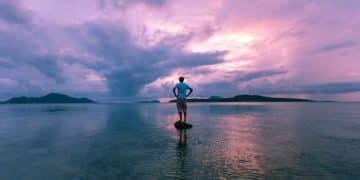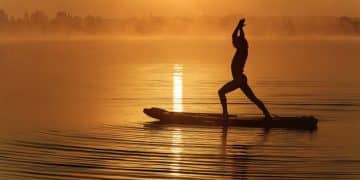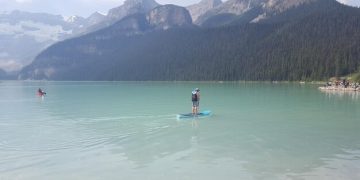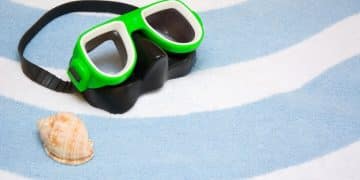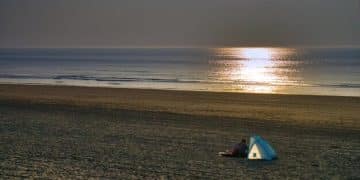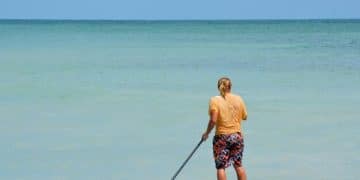Paddleboarding for Beginners: Master the Basics in 3 Hours – Tutorial
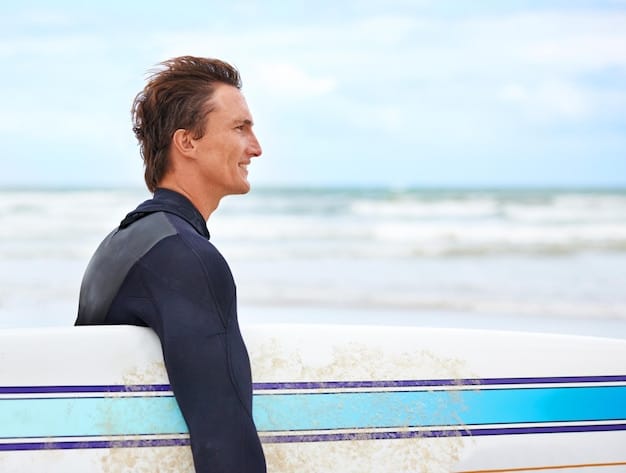
Mastering the basics of paddleboarding is achievable within a three-hour dedicated session, encompassing equipment familiarity, fundamental paddling techniques, and safety protocols essential for beginners to confidently navigate calm waters.
Embarking on the serene and engaging world of paddleboarding can seem daunting at first glance, but with the right guidance, anyone can quickly gain proficiency. This comprehensive Paddleboarding for Beginners: Master the Basics in 3 Hours with This Step-by-Step Tutorial is meticulously crafted to transform novices into confident paddlers in just a single afternoon, equipping you with essential skills and a deep understanding of safety.
understanding your paddleboard and essential gear
Paddleboarding is an increasingly popular water sport that offers a unique blend of fitness, relaxation, and exploration. Before you even set foot on the board, it’s crucial to understand the equipment you’ll be using. This foundational knowledge is key to a successful and enjoyable first experience. Familiarizing yourself with each piece of gear will not only enhance your learning curve but also significantly improve your safety on the water.
the paddleboard itself
Paddleboards come in various shapes and sizes, each designed for different purposes, but for beginners, stability is paramount. Boards are typically made from either solid materials like epoxy or are inflatable (iSUP). iSUPs are often recommended for beginners due to their durability, portability, and forgiving nature. Look for a wider, longer board as these dimensions generally offer greater stability, making it easier to find your balance. The volume and weight capacity are also important; ensure the board can comfortably support your weight and any gear you might carry.
- Board Type: Inflatable (iSUP) for portability and durability.
- Dimensions: Wider and longer boards offer more stability.
- Fin Setup: Single or multi-fin setups affect tracking and maneuverability.
the paddle: your propulsion system
Your paddle is your primary means of propulsion and steering. A common mistake beginners make is using a paddle that is too long or too short. The general rule of thumb is that the paddle should be about 6 to 8 inches taller than you are when standing. Adjustable paddles are ideal for beginners as they allow you to fine-tune the length for comfort and efficiency. It’s also important to understand the blade orientation; the angled part of the blade should always face away from you during a stroke to maximize propulsion.
personal flotation device (PFD)
A PFD, or life vest, is non-negotiable. Even if you’re a strong swimmer, wearing a PFD can save your life in unexpected situations, such as falling off in deeper waters or becoming disoriented. Many regions have regulations requiring PFDs for paddleboarders, so it’s always best to check local laws. There are various types of PFDs, but a Type III vest is generally suitable for paddleboarding as it allows for a full range of motion.
leash: your connection to the board
The leash is a vital safety component that keeps you tethered to your board. If you fall off, the board won’t drift away, leaving you stranded. Ankle leashes are common, but coiled leashes that attach to your calf or knee are also popular, especially in calmer waters, as they are less likely to drag. Always ensure your leash is in good condition and properly attached before heading out. The board serves as a large flotation device, so staying connected to it is crucial for safety.
Understanding these core components and their proper use sets the stage for a confident and secure paddleboarding experience. By taking the time to fit your gear correctly and familiarize yourself with each element, you’ll be well-prepared for the practical steps of getting on the water.
pre-launch preparations and safety checks
Before you even dip your paddle into the water, a series of important preparations and safety checks must be completed. These steps are crucial for ensuring a safe and problem-free outing. Neglecting these details can lead to avoidable difficulties or even dangerous situations. A well-prepared paddler is a safe paddler, and this phase is where good habits begin.
choosing your launch site
Selecting the right launch site is paramount for beginners. Opt for calm, flat bodies of water with minimal boat traffic, such as a tranquil lake, a sheltered bay, or an incredibly slow-moving river. Avoid areas with strong currents, large waves, or numerous obstacles. A sandy beach or gentle ramp provides an easy entry point, allowing you to gradually get a feel for the board in shallow water before venturing further. Assess the wind direction; paddling against strong winds can be extremely challenging for beginners.
- Calm Waters: Lakes, sheltered bays, slow rivers.
- Minimal Traffic: Avoid busy areas with boats or jet skis.
- Gentle Entry: Sandy beaches or ramps are ideal.
checking weather and water conditions
Always check the weather forecast before you go. Look for calm winds (ideally less than 10 mph) and clear skies. Be aware of any sudden changes in weather patterns, such as approaching storms. Water temperature is also a critical factor; if the water is cold, consider wearing a wetsuit, even if the air temperature is warm. Hypothermia can set in quickly in cold water. Knowing these conditions helps you dress appropriately and plan the duration of your paddle.
attaching your leash and PFD
These are your primary safety devices. Ensure your leash is securely attached to your ankle or calf and to the D-ring on the tail of your board. Its purpose is to keep your board from being swept away if you fall. Your personal flotation device (PFD) should fit snugly but comfortably. Make sure all buckles and zippers are fastened. It should allow for full range of motion while paddling but offer adequate buoyancy if you go into the water.
carrying your board to the water
Properly carrying your paddleboard prevents damage to the board and injury to yourself. Most boards have a central carry handle. If it’s a non-inflatable board, you might need to carry it under your arm or on your head. For iSUPs, they often have convenient handles. Always carry your board with the fins facing away from your body to avoid tripping or catching them on obstacles. When placing it in the water, guide it gently to avoid scraping the fins on rocks or the bottom.
basic safety considerations
In addition to your gear, there are crucial safety rules. Always tell someone where you are going and when you expect to return. Consider bringing a whistle or other signaling device, especially if you plan to paddle further from shore. Carry water to stay hydrated, and wear sunscreen and a hat to protect yourself from the sun. Understanding potential hazards like submerged objects, changing tides, and boat traffic will further enhance your safety awareness.
These preparations embody responsible paddleboarding. By taking the time to address each point, you create a foundation of safety and confidence that allows you to fully enjoy your time on the water.
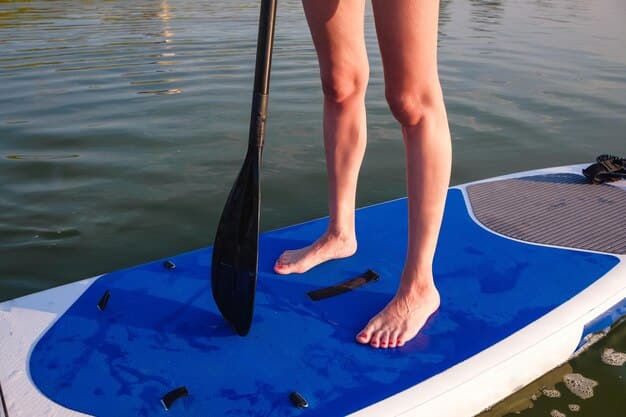
getting on the board and finding your balance (30 minutes)
The transition from land to standing on a paddleboard is often the most challenging part for beginners. It requires a gentle approach, patience, and a willingness to adjust. The key is to start in shallow water, allowing you to regain your footing easily if you lose balance. This phase focuses on developing core stability and understanding how your body weight subtly influences the board’s behavior.
starting on your knees
Before attempting to stand, begin on your knees. This provides a lower center of gravity and a much more stable platform. Wade into the water until it’s about knee-deep. Place your paddle across the front of the board, perpendicular to its length, with the shaft resting on the board as a temporary balancing aid. Gently climb onto the board, positioning your knees roughly in the middle, just behind the carry handle. Keep your gaze directed forward, towards the horizon, rather than down at your feet. This helps with balance.
paddling from your knees
Once on your knees, practice some basic paddle strokes. This familiarizes you with the paddle’s feel and how it moves the board. Start with short, controlled strokes on alternating sides. Engage your core, not just your arms. Feel how the board responds to your movements. This kneeling phase builds confidence and muscle memory before you attempt to stand, providing a secure base to master the very first movements. It’s also an excellent way to get a feel for paddling into the breeze or against a gentle current, even if your ultimate goal is to stand.
the transition to standing
This is often where beginners require the most practice. From your kneeling position, place your paddle across the board again, or hold it like a balancing pole. One hand should be on the paddle shaft, the other supporting the paddle blade on the board. Slowly bring one foot up to where your knee was, then the other. Keep your feet parallel and shoulder-width apart, positioned over the board’s center line. Your knees should be slightly bent, and your back straight. Avoid looking down at your feet; focus on a distant point.
finding your balance and posture
It’s natural to feel wobbly at first. The key to maintaining balance is to use your core muscles, not just your legs. Keep your knees slightly bent and your body relaxed. Distribute your weight evenly between both feet. If you feel yourself losing balance, remember that small, quick paddle strokes can often help stabilize you. Think of your paddle as an extension of your balance system. Your posture should be upright but not rigid, with your head up and shoulders relaxed.
Falling is part of the learning process. It’s important to fall safely, away from the board, and then practice getting back on. Getting back on usually involves swimming to the tail of the board, positioning yourself parallel to it, and using your arms to pull yourself up onto your stomach, then rolling onto your knees. This section is all about repetition and adjusting to the subtle movements of the board beneath you.
fundamental paddling techniques (45 minutes)
Once you’re comfortable standing (or kneeling, if you prefer to start there), the next crucial step is to master the basic paddling techniques. Effective paddling isn’t just about moving water; it’s about engaging your entire body to create efficient and powerful strokes, allowing you to navigate with ease. This section covers the fundamental forward stroke, turning, and stopping.
the basic forward stroke
The forward stroke is the most important technique to learn. It’s not just an arm exercise; it involves your core and upper body.
Begin by reaching forward with the paddle, inserting the blade fully into the water as far as you can comfortably. The blade should be angled so the curved part faces away from you.
Pull the paddle back towards your feet, keeping your arms relatively straight and rotating your torso. Imagine paddling a canoe, using your core to drive the movement.
Once the paddle reaches your feet, lift it cleanly out of the water and repeat on the other side. Alternate strokes, keeping them smooth and consistent.
- Reach: Extend paddle fully forward.
- Catch: Insert blade completely into water.
- Power: Rotate torso, pull paddle back to feet.
- Release: Lift paddle cleanly out of water.
steering and turning techniques
Turning on a paddleboard is achieved through various stroke manipulations. For a simple turn, you can use sweeping strokes or by paddling on one side only.
To turn left: Use a forward stroke on the right side of the board but arch the stroke wide, away from the board in a sweeping motion. This creates leverage that turns the nose of the board.
To turn right: Perform a sweeping stroke on the left side.
For sharper turns, you can use a “reverse sweep” by placing the paddle at the tail of the board and sweeping it forward, or by using a “pivot turn” where you shift your weight to the tail, raising the nose, and then sweep to turn. For beginners, simple sweeping strokes are sufficient.
stopping and slowing down
Stopping efficiently is as important as moving forward. The primary way to stop is by using a reverse paddle stroke.
To do this, place the paddle blade in the water near the rear of your board and push it forward towards the nose. This acts as a brake.
The harder you push against the water, the quicker you will slow down or stop.
You can also slow down by simply stopping paddling and letting the board glide to a halt, or by dragging the paddle gently through the water beside the board. Mastering these basic maneuvers gives you full control over your board.
Practicing these techniques will build your confidence and refine your movements on the water. Repetition is key; the more you practice, the more natural and fluid your paddling will become, allowing you to venture further and explore more confidently.
advanced balancing maneuvers and troubleshooting (45 minutes)
Once you’ve grasped the basic paddling techniques, it’s time to refine your stability and learn how to handle minor wobbles and falls. Advanced balancing maneuvers are not about performing tricks, but rather about developing a deeper sense of connection with your board and an intuitive understanding of weight distribution. Troubleshooting common issues prepares you for real-world scenarios on the water.
weight distribution and body awareness
True paddleboarding stability comes from understanding how your weight influences the board. Practice shifting your weight subtly forward, backward, and side-to-side while maintaining your balance. Notice how the board responds. This body awareness allows you to make micro-adjustments to stay upright. For instance, if a small wake approaches, shifting your weight slightly back onto your heels can help absorb the impact, or stepping your feet wider will provide a more stable base.
handling chop and small wakes
Calm water is ideal for beginners, but you’ll inevitably encounter minor disturbances. When faced with small chop or wakes from passing boats, turn your board to meet the disturbance head-on, at a 90-degree angle. This allows the nose of the board to cut through the chop, providing more stability than if the waves hit the board broadside. Keep your knees bent and your body relaxed, allowing yourself to “flow” with the board’s motion rather than resisting it rigidly.
falling safely and re-mounting
Falling off is an inevitable part of paddleboarding, even for experienced paddlers. The key is to fall safely and know how to get back on.
When you feel yourself falling, try to fall away from the board to avoid hitting it or being hit by the paddle. Protect your head.
To remount, swim to the side of the board near its center. Position your body parallel to the board. Reach across the board with both hands and pull yourself up onto your stomach, using a “belly flop” motion. Once on your stomach, or on your knees, slowly work your way back to your standing position. Practice this a few times in shallow water so it becomes second nature.
- Fall Away: Protect yourself from the board and paddle.
- Swim to Center: Get alongside the board at its widest point.
- Pull Up: Use arms to pull torso onto board, then follow with legs.
- Regain Position: Transition to kneeling then standing.
common troubleshooting tips
If you find yourself struggling, consider these points:
- Paddle Length: Is your paddle the correct height? Too short or too long can throw off your balance and efficiency.
- Foot Placement: Are your feet shoulder-width apart and centered on the board? Adjusting this can significantly improve stability.
- Gaze Point: Are you looking at the horizon, or down at your feet? Looking ahead helps maintain equilibrium.
- Relaxation: Are you too stiff? A relaxed body absorbs movement better than a rigid one.
By actively engaging with these techniques and troubleshooting common issues, you’ll not only improve your physical skills but also build the mental resilience required to adapt to varying water conditions confidently.
paddling etiquette and environmental awareness (30 minutes)
Paddleboarding isn’t just about personal enjoyment; it’s also about sharing the waterways responsibly and protecting the natural environment. Understanding paddling etiquette and practicing environmental awareness ensures a harmonious experience for everyone and preserves the beauty of our aquatic playgrounds. This section covers respectful behavior on the water and minimizing your ecological footprint.
rules of the waterway
Just like roads, waterways have rules of navigation.
- Right-of-Way: Generally, smaller, less maneuverable vessels yield to larger ones. Human-powered crafts often have right-of-way over motorized boats, but always err on the side of caution. Paddleboarders should also yield to swimmers and divers.
- Stay Aware: Always be aware of your surroundings, including other paddlers, boats, and obstacles. Pay attention to buoys and markers.
- Passing: When passing other paddlers, do so politely and give them adequate space. Avoid creating large wakes that could destabilize others.
These are basic courtesies that contribute to a safer and more enjoyable experience for all. Respecting other water users prevents collisions and fosters good relationships.
respecting wildlife and marine life
Our waterways are home to diverse ecosystems.
- Maintain Distance: Give wildlife plenty of space. Do not approach marine animals, especially marine mammals or birds nesting on shore. Disturbing them can cause stress, alter natural behaviors, and is often illegal.
- Observe Quietly: Enjoy observing animals from a distance. Avoid loud noises or sudden movements that could startle them.
- Do Not Feed: Never feed wildlife. It can lead to animals becoming dependent on humans and can harm their health.
Protecting these creatures ensures their continued well-being and allows future generations to enjoy observing them in their natural habitat.
leave no trace principles
The “Leave No Trace” philosophy is paramount for ensuring our natural spaces remain pristine.
- Pack It In, Pack It Out: Everything you bring with you should leave with you. This includes all trash, food scraps, and even human waste where facilities are not available. Better yet, pick up any litter you come across.
- Dispose of Waste Properly: Use designated trash receptacles. If none are available, pack your trash out.
- Minimize Impact: Stay on designated paths where possible and avoid trampling vegetation. When landing your board, choose durable surfaces like sandy beaches or established launch points rather than fragile ecosystems.
By adhering to these principles, paddleboarders become stewards of the environment, actively contributing to the preservation of the natural beauty that makes this sport so appealing. A conscious paddler understands their responsibility to protect the places they visit.
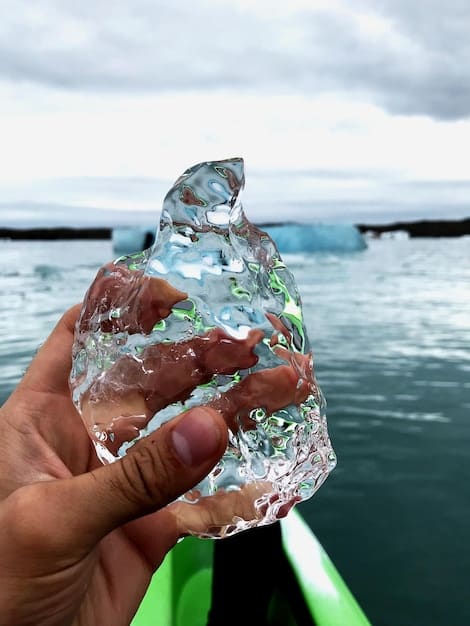
post-paddle care and further progression (30 minutes)
Completing your first paddleboarding session marks a significant achievement. However, the experience doesn’t end when you leave the water. Proper care for your equipment and a clear path for skill progression ensure longevity for your gear and consistent improvement for yourself. This final section provides guidance on essential post-paddle routines and how to continue your paddleboarding journey.
cleaning and storing your equipment
Proper cleaning and storage are vital for prolonging the life of your paddleboard and gear.
- Rinse Everything: After each use, especially if paddling in saltwater, rinse your board, paddle, leash, and PFD with fresh water. This removes salt, sand, and dirt that can cause wear and tear.
- Dry Thoroughly: Ensure all equipment is completely dry before storing. This prevents mold, mildew, and corrosion. For iSUPs, this is particularly important to prevent fabric degradation.
- Proper Storage: Store your board in a cool, dry place, away from direct sunlight. UV rays can degrade materials over time. If it’s an iSUP, deflate it and roll it loosely into its bag. If it’s a solid board, store it on a rack or padding to prevent pressure points.
A little post-paddle care goes a long way in ensuring your gear is ready for your next adventure.
reflecting on your first session
Take a moment to reflect on your paddleboarding debut. What felt easy? What was challenging? Did you find your balance quickly, or did it take more effort? Understanding your strengths and weaknesses will help you focus your practice in future sessions. Celebrate your achievements, no matter how small, and acknowledge areas where you can improve. This mindful reflection is crucial for genuine skill development.
what’s next: intermediate skills and exploration
Your three-hour tutorial is just the beginning. The world of paddleboarding offers endless opportunities for progression:
- Advanced Strokes: Learn power strokes, draw strokes, and bracing strokes to improve efficiency and control.
- Paddling in Different Conditions: Gradually introduce yourself to light chop, small waves, or even mild currents once you are confident.
- Yoga and Fitness: Many paddlers use their boards for on-water fitness routines, including yoga, which further challenges balance and core strength.
- Touring and Exploration: Venture on longer paddles, exploring remote coves, rivers, or coastlines.
- Downwinding and Surfing: For the adventurous, learning to “downwind” with the wind or even surf waves on a SUP offers thrilling new dimensions.
Consider joining a local paddleboarding club or taking an intermediate lesson to connect with other enthusiasts and receive expert guidance. The journey of paddleboarding is continuous learning and exploration.
| Key Point | Brief Description |
|---|---|
| 🏄♂️ Gear Up | Understand your board, paddle, PFD, and leash for safety and performance. |
| 🧘♀️ Balance First | Start kneeling, then transition to standing. Focus on core stability and gaze. |
| 🛶 Stroke Basics | Master the forward stroke, turns, and stops for efficient navigation. |
| 🌊 Stay Safe | Learn to fall safely, remount, and practice waterway etiquette. |
frequently asked questions about paddleboarding for beginners
▼
Core strength is incredibly important for paddleboarding, as it provides the primary stability and power for your strokes. While you don’t need to be an athlete, a strong core helps maintain balance, prevents fatigue, and allows for more efficient paddling. Engaging your abdominal muscles will significantly improve your control and reduce strain on your arms and back during a session.
▼
For paddleboarding, wear comfortable, quick-drying clothing that allows for full range of motion. Swimsuits, wetsuits (if water is cold), or athletic wear made from synthetic materials are ideal. Avoid cotton as it stays wet and can make you cold. Don’t forget sun protection: a hat, sunglasses, and reef-safe sunscreen are essential, as UV rays reflect off the water, intensifying exposure.
▼
While wearing a Personal Flotation Device (PFD) is always mandatory, it is strongly recommended that you have basic swimming abilities before paddleboarding. The PFD will keep you afloat, but being able to swim helps you maneuver yourself back to the board or shore if you fall in, especially in unexpected conditions. Always prioritize safety and exercise caution in unfamiliar waters.
▼
Choosing the right paddleboard size primarily depends on your weight, height, and intended use. Beginners generally benefit from wider and longer boards (10-11 feet in length, 32-34 inches in width) as they offer superior stability. These dimensions make it easier to learn and maintain balance. Consult a rental shop or instructor for personalized recommendations based on your physique and local water conditions.
▼
Yes, paddleboarding provides an excellent full-body workout. It engages your core for balance, arms and back for paddling, and legs for stability. It’s a low-impact exercise that improves balance, strength, and endurance. Depending on your intensity and duration, you can burn a significant number of calories, making it a fun and effective way to stay active outdoors.
conclusion
Embarking on the paddleboarding journey can be a deeply rewarding experience, offering both tranquil moments of connection with nature and an invigorating full-body workout. This comprehensive guide, focusing on the essential steps within a three-hour framework, aims to equip every beginner with the confidence and fundamental skills needed to navigate the waters safely and efficiently. Remember, mastering the art of paddleboarding is a progression, and each session builds upon the last, opening doors to new adventures and a deeper appreciation for our aquatic environments.
